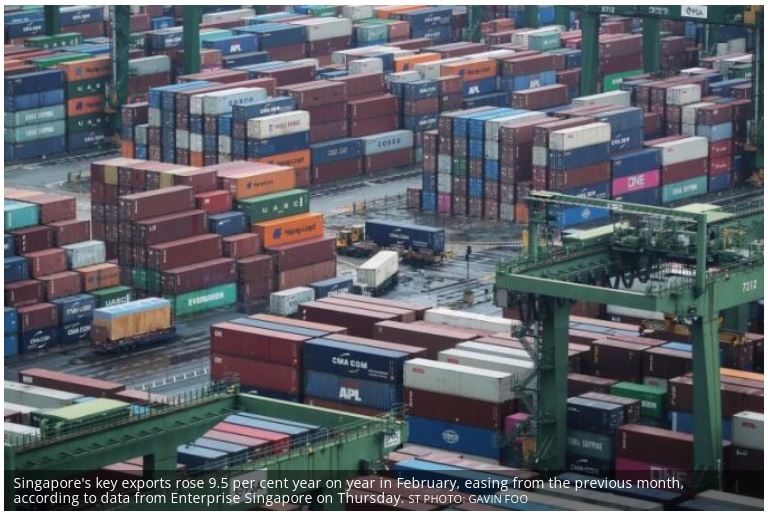Singapore non-oil exports growth eases to 9.5% in Feb
SINGAPORE’S key exports rose 9.5 per cent year on year in February, easing from the previous month, according to data from Enterprise Singapore (ESG) on Thursday (Mar 17).
This came on the back of growth in both electronics and non-electronics shipments, as non-oil domestic exports (NODX) to Singapore’s top 10 markets grew as a whole in February.
It is however slower than January’s surprisingly strong growth of 17.6 per cent as well as private-sector economists’ expectations of a 16.5 per cent growth.
On a month-on-month seasonally adjusted basis, exports fell 2.8 per cent, compared with January’s 5 per cent expansion, as non-electronic exports fell while that for electronics grew.
In February, the seasonally adjusted value of NODX reached S$17.6 billion, lower than the previous month’s S$18.1 billion.
Barclays regional economist Brian Tan noted that February’s showing was dragged by sharp declines in shipments of non-monetary gold and specialised machinery as well as an unfavourable base effect from last year.
“The lower-than-expected print stemmed partly from a plunge in shipments of non-monetary gold, which tend to be volatile,” Tan said, adding that the concurrent rise in pharmaceutical exports, another typically volatile segment, was insufficient to offset this.
“Excluding exports of pharmaceuticals and non-monetary gold, we estimate NODX rose slightly in sequential terms,” he added.
Shipment of electronic products grew 11.6 per cent in February, extending the 14 per cent increase in January. This was attributed mostly to capacitors, which rose a whopping 247.6 per cent, followed by integrated circuits and disk media products.
The growth in non-electronic exports moderated in February to 8.8 per cent, slower than the previous month’s 18.6 per cent expansion. Structures of ships and boats, pharmaceuticals and petrochemicals contributed the most to this.
Key exports to the European Union rose 53.7 per cent in February, picking up pace from the previous month’s 32.3 per cent. This was followed by Malaysia at 29.8 per cent, up from 20.1 per cent in January. Exports to China grew 19.2 per cent in February, compared with the 26.1 per cent expansion in the previous month.
Meanwhile, NODX to South Korea, Hong Kong, the United States, Thailand and Indonesia declined in February.
In particular, exports to emerging markets fell 29.6 per cent after growing 21.6 per cent in January, mainly due to a decline for Cambodia, Laos, Myanmar and Vietnam as a whole, the Caribbean and the Middle East.
Overall, total trade rose by 21 per cent in February, easing from the previous month’s 24.9 per cent.
Sequentially, total trade grew 0.9 per cent, extending the 0.1 per cent rise in January.
On a seasonally adjusted basis, total trade reached S$109 billion in February, slightly higher than the previous month’s S$108 billion.
Noting that the disappointment in February’s export numbers stem mainly from the poor performance of non-monetary gold, Tan said: “We doubt this is reflective of a broader drop in external demand, especially as electronics exports rose in sequential terms. Exports of specialised machinery are also unlikely to stay low for long when there is still ample global demand for semiconductors.”
However, Sung Eun Jung, senior economist from Oxford Economics, believes exports could weaken in the coming months with the Russia-Ukraine war dampening global trade and growth prospects.
“Ongoing supply chain disruptions pose further challenges to trade, with localised lockdowns in China adding to temporary disruptions,” said Jung.
ING senior economist Nicholas Mapa said NODX could see more moderation in the months ahead, with trade activity expected to slow amid a dimming global growth outlook.
Source: https://www.businesstimes.com.sg/government-economy/singapore-non-oil-exports-growth-eases-to-95-in-feb


 English
English




